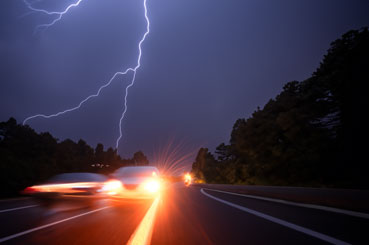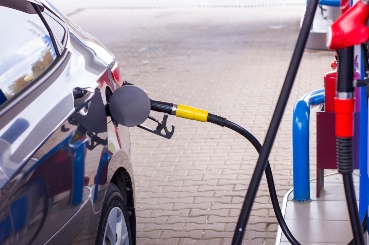Driving in a thunderstorm can be a nerve-wracking experience. The dark clouds, heavy rain, and frequent lightning strikes can make anyone wonder about their safety on the road.
If you’ve ever wondered what happens if lightning strikes a car and whether it’s safe to drive in a thunderstorm, you’re not alone. In this blog, we’ll explore the fascinating relationship between lightning and cars, debunk some myths, and provide tips on what to do if lightning strikes your vehicle.

Is it Safe to Drive in a Thunderstorm?
Driving in a thunderstorm can be risky and is generally not recommended. Thunderstorms can bring a combination of hazards such as heavy rainfall, reduced visibility, strong winds, hail, and lightning. These conditions can make the road treacherous and increase the likelihood of accidents.
Hydroplaning, where a layer of water forms between the tyres and the road surface, can occur during heavy rain, leading to loss of control over the vehicle.
Lightning strikes can also be a concern, although cars do offer some protection due to their metal frames.
It’s crucial to exercise caution, reduce speed, maintain a safe following distance, and consider pulling over and waiting for the storm to pass if conditions become too hazardous. In severe thunderstorms, it’s always safer to find shelter and wait until the weather improves before resuming your journey.
What Happens if Lightning Strikes a Car?
When lightning strikes a car, it typically travels around the exterior metal shell (the conductive Faraday cage), protecting the occupants inside. The lightning’s energy is conducted around the car and into the ground, leaving the passengers unharmed. However, there can be some consequences:
1. Electrical System Damage:
Lightning can damage the vehicle’s electrical system, including the battery, computer, and other electronics.
2. Tyre Blowouts:
Lightning can cause tyres to explode due to the sudden heating of the air inside.
3. Fire Risk:
In rare cases, lightning strikes can ignite a vehicle’s fuel tank or other flammable materials.

Are You Safe from Lightning in a Car?
Generally, you are safer in a car during a lightning storm than standing outside. The metal frame of a car acts as a Faraday cage, directing the electrical current around the exterior and into the ground.
However, it’s important to note that convertible cars, bicycles, motorcycles, and other non-metallic vehicles do not offer the same level of protection.
What Should You Do if Lightning Strikes Your Car?
If lightning does strike your car, it can be a frightening experience. Here’s what you should do:
Stay Calm:
It’s natural to be startled, but remain as calm as possible.
Check for Damage:
After the storm has passed, inspect your car for damage, especially the tyres and electrical systems.
Seek Medical Help:
If anyone inside the car is injured, seek medical attention immediately.
Contact Authorities:
If a fire has started, or if you’re stranded, contact the appropriate authorities for assistance.
Lightning Myths
There are several myths surrounding lightning and cars that need to be debunked:
- Rubber Tyres: Contrary to popular belief, rubber tyres do not insulate a car from lightning. It’s the metal frame that provides protection.
- Lightning Rods: Adding a lightning rod to your car won’t make it safer during a lightning storm. The existing metal frame already serves as a lightning conductor.

Is a Car a Safe Place to Be During Lightning?
While a car offers a degree of protection during a lightning storm, it’s important to remember that the safest place to be is indoors.
If you can safely exit the road and find shelter in a sturdy building during a thunderstorm, that’s always the best option.
Met Office and Weather Warnings
Pay attention to weather warnings from reliable sources like the Met Office or other meteorological services. They provide valuable information about approaching thunderstorms, allowing you to plan your travel accordingly and stay safe.
In conclusion, while a car can offer some protection from lightning strikes during a thunderstorm, it’s essential to exercise caution and prioritise safety. If you have the option to avoid driving in severe weather, it’s usually the best choice.
Remember, it’s not just about lightning; thunderstorms can bring a host of other hazards that can make driving treacherous. Stay informed, stay safe, and be prepared when Mother Nature decides to put on a show in the skies above.




